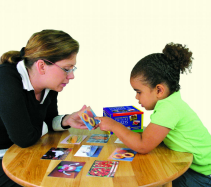Part 2 of 4: Building Vocabulary
Building Expressive Vocabulary
This is the step where your child learns to actually say the words out loud. All of the tasks we just described in the previous Autism and Language article come into play when building your child’s expressive vocabulary. Picture cards are a useful tool again, because it just isn’t feasible to bring every object directly to your child. We certainly want them to learn the words bus and airplane, but it’s difficult to get those items into your living room!
The basic idea for building expressive vocabulary using picture cards is just to hold the card up and ask your child “what is it?” The intricacy comes in knowing how to prompt your child and how to fade that prompt. We talked above about the importance of your child being able to imitate the words that you say. Imitation is the basis for the prompts you will use to build your child’s expressive vocabulary.
The first several times you ask your child the name of a new picture, you will likely have to model the word for him or her. For example, you ask your child “What is it?” If you do not get a response, you say “apple.” Ideally your child repeats the word “apple.” After a few tries, you can shorten your prompt to “app….” And then to “aaaa…….” And then perhaps to just opening your mouth as if to say “aaaa...” but not making a sound.
A Comprehensive Picture Card Library
It is a good idea to have a large selection of pictures ready to go when you start to teach the lessons we just described. Here are a few tips to help you choose or take appropriate pictures:

- Start with words that are familiar to your child. Words like apple, cup and cookies may be better than saxophone or stethoscope.
- Start with pictures on a plain white, or a distraction-free background.
- Make sure to have duplicates available for the matching tasks when you first start out.
- Consider taking multiple pictures of the same item (6 different apples for example) to help your child generalize their newly learned words.
- As your child becomes more comfortable learning new words, move to more natural settings for your pictures.
- Have a broad range of pictures, across multiple categories, ready for when your child is ready to move forward!
- If you take the pictures yourself, consider having them laminated for durability.
If you would like to purchase a set of photo cards to meet the needs of your new language program, Stages Learning Materials publishes a 350-Card Set of photo flash cards called the Language Builder Picture Card Set, which is specifically tailored to meet the needs of an early language vocabulary building program.
Read other articles in our Autism and Language series:
Part 1: Encouraging Emerging Language and Receptive Vocabulary

Angela Nelson, J.D., Ed.M.
Angela Nelson is the creator of the widely-recognized Language Builder Picture Card Series, and the creator and lead author for the Language Builder ARIS curriculum. Angela received her BA and JD from UCLA where she studied and practiced behavior psychology under Dr. Ivar Lovaas, and her Ed.M. at the Harvard Graduate School of Education, with a focus on technology innovation and education. As Founder and CEO of Stages Learning Materials, Angela has created autism, special needs and early childhood curriculum products since 1997. In addition to her duties at Stages, Angela writes for multiple industry publications and is Chair of the Education Market Association.





